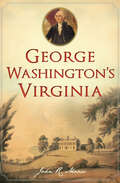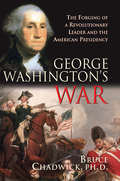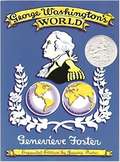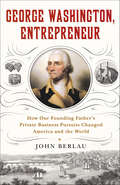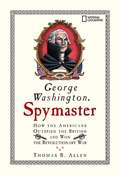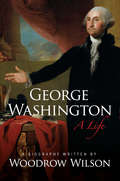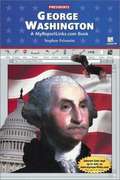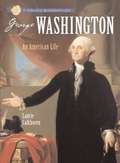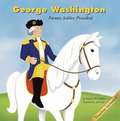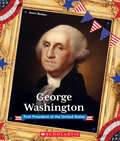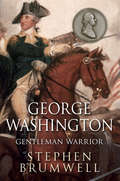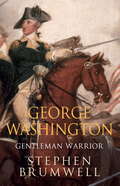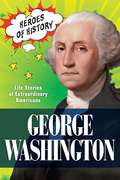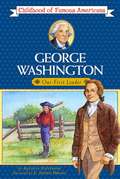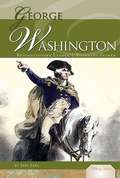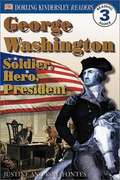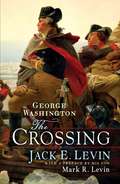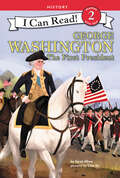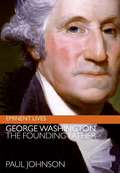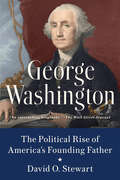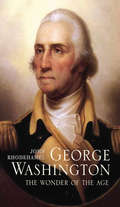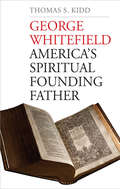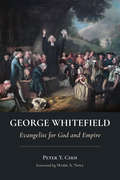- Table View
- List View
George Washington's Virginia (History And Guide Ser.)
by John R. MaassGeorge Washington slept, worked, and fought here . . . A historian&’s guide to Virginia sites and landmarks associated with the Founding Father. Born in the Tidewater region, George Washington was reared near Fredericksburg and took up residence at Mount Vernon along the Potomac River. As a young surveyor, he worked in Virginia&’s backcountry. He began his military career as a Virginia militia officer on the colony&’s frontier. The majority of his widespread landholdings were there—and his entrepreneurial endeavors ranged from the swamplands of the Southeast to the upper Potomac River Valley. In this book, historian John R. Maass explores the numerous sites all over the Commonwealth associated with Washington—and demonstrates their lasting importance. Includes photos and illustrations
George Washington's War: The Forging of a Revolutionary Leader and the American Presidency
by Bruce ChadwickDrawing on archival and other sources, Chadwick (American history, Rutgers U.) offers a new perspective on the well-known story of the plight of General Washington and his men at Valley Forge. He argues that the future president developed a model of leadership for dealing with national emergencies when he campaigned to secure emergency supplies for his troops. Includes period illustrations. Annotation ©2004 Book News, Inc., Portland, OR (booknews.com)
George Washington's World
by Joanna Foster Genevieve FosterFoster's telling of the life story of George Washington does justice to the man it celebrates.
George Washington, Entrepreneur: How Our Founding Father's Private Business Pursuits Changed America and the World
by John BerlauA business biography of George Washington, focusing on his many innovations and inventions.George Washington: general, statesman...businessman? Most people don't know that Washington was one of the country's first true entrepreneurs, responsible for innovations in several industries. In George Washington, Entrepreneur, John Berlau presents a fresh, surprising take on our forefather's business pursuits.History has depicted Washington as a gifted general and political pragmatist, not an intellectual heavyweight. But he was a patron of inventors and inveterate tinkerer, and just as intelligent as Jefferson or Franklin. His library was filled with books on agriculture, history, and philosophy. He was the first to breed horses with donkeys to produce the American mule. On his estate, he grew countless varieties of trees and built a greenhouse full of exotic fruits, herbs, and plants. Unlike his Virginia neighbors who remained wedded to tobacco, Washington planted seven types of wheat. His state-of-the-art mill produced flour which he exported to Europe in sacks stamped "G. Washington"—one of the very first branded food products. Mount Vernon was also home to a distillery and became one of the largest American whiskey producers of the era.Berlau's portrait of Washington, drawn in large part from his journals and extensive correspondence, presents a side of him we haven't seen before. It is sure to delight readers of presidential biography and business history.
George Washington, Spymaster: How the Americans Outspied the British and Won the Revolutionary War
by Thomas B. AllenThe award-winning National Geographic book that presents the untold story of the invisible war behind the American Revolution. A riveting tale of intrigue, spies, counterspies and secret agents,George Washington, Spymaster is a unique and entertaining account of one of the most important chapters in our nation's history. The compelling narrative reveals the surprising role played by the first commander-in-chief, General George Washington in the War of Independence. Follow the action as 1775 dawns, and Washington finds himself in serious trouble. At war with Britain, the world's most powerful empire, his ragtag army possesses only a few muskets, some cannons, and no money. The Americans' only hope is to wage an invisible war_a war of spies, intelligence networks, and deception. Enter the shadowy world of double agents, covert operations, codes and ciphers_a world so secret that America's spymaster himself doesn't know the identities of some of his agents. Meet members of the elusive Culper Ring, uncover a "mole" in the Sons of Liberty, and see how invisible ink and even a clothesline are used to send secret messages. You can even use Washington's own secret codebook, published here for the first time. Experience at close quarters the successes and failures of the Americans as they strive to outwit the British. Meet the chief of covert operations, one Benjamin Franklin, and several other surprising players in America's secret war. Author Thomas B. Allen has sifted through dozens of historical documents and coded letters to uncover the facts about a time shrouded in secrets.
George Washington: A Life
by Woodrow WilsonA president-to-be chronicles the life and times of the historic first Chief Executive in this insightful biography. Before his entry into politics, Woodrow Wilson was a noted educator and historian, and his erudition shines in this fascinating profile of George Washington's rise to leadership. Wilson traces the iconic figure's path from his birth in a tranquil settlement through his explosive military career and precedent-setting administration, providing a fascinating portrait of colonial America along the way. "Bred a gentleman and man of honor in the free school of Virginian society," Washington came of age with the first stir of revolutionary events. His training as a surveyor made him an expert woodsman and hardy traveler, qualities that served him well during his rough apprenticeship in the French and Indian War. At the age of 44, the Revolution found him an experienced commander who organized and trained the army in addition to fighting in its battles and serving as a symbol of organized resistance. After his selfless resignation of power upon achieving victory, Washington was compelled to take on a task even harder than those of wartime: the formation of a unified national government. This edition of Wilson's scholarly yet readable biography is splendidly illustrated with portraits and maps as well as illustrations by Howard Pyle, among others, who collaborated closely with the author on depictions of episodes from Washington's extraordinary life.
George Washington: A MyReportLinks.com Book
by Stephen FeinsteinCovers the lives, accomplishments, and political careers of the American presidents. Pre-evaluated Report Links back up each book.
George Washington: An American Life
by Laurie Calkhoven"First in war, first in peace, and first in the hearts of his countrymen" and first in the minds of schoolchildren, who learn about George Washington as soon as they begin studying American history. From Washington's Virginia childhood, through his days as a soldier and general, to his inauguration as the first President of the brand-new United States, and into retirement, this biography captures the full breadth and achievements of his life. It covers both the personal and the private, reveals his views on everything from governmental power to the abolition of slavery, and separates fascinating truth from well-worn legend including that infamous, but false, tale about chopping down the cherry tree.
George Washington: Farmer, Soldier, President (Biographies Series)
by Jeff Yesh Pamela NettletonGive readers a fresh look into the fascinating lives of six famous Americans. This Series is aligned with the Standard, "The History of the United States' Democratic Principles and Values, and the Peoples from Many Cultures Who Contributed to Its Cultural, Economic, and Political Heritage," as required by the National Council for History.
George Washington: First President of the United States (Presidential Biographies)
by Jevon BoldenMeet George Washington, our first president-who many say is the greatest leader our nation has known.When Washington took office, no one knew what the president's job should be, or how the country should be run! During his two terms, Washington set the standard for the office and helped shape our democracy. He will always be remembered.This series of engaging, in-depth books introduces readers to the men who have led our country since its very first days. Lively text and colorful illustrations are supplemented by fun facts, a timeline, and even a sampling of the subject's most famous quotes.Presidential Biographies will be the first books kids reach for when writing a report-or if they're simply looking for a fascinating read!
George Washington: Gentleman Warrior
by Stephen BrumwellWinner of the prestigious George Washington Book Prize, George Washington is a vivid recounting of the formative years and military career of "The Father of his Country," following his journey from brutal border skirmishes with the French and their Native American allies to his remarkable victory over the British Empire, an achievement that underpinned his selection as the first president of the United States of America. The book focuses on a side of Washington that is often overlooked: the feisty young frontier officer and the early career of the tough forty-something commander of the revolutionaries' ragtag Continental Army.Award-winning historian Stephen Brumwell shows how, ironically, Washington's reliance upon English models of "gentlemanly" conduct, and on British military organization, was crucial in establishing his leadership of the fledgling Continental Army, and in forging it into the weapon that secured American independence. Drawing on a wide range of sources, including original archival research, Brumwell brings a fresh new perspective on this extraordinary individual, whose fusion of gentleman and warrior left an indelible imprint on history.
George Washington: Gentleman Warrior
by Stephen BrumwellWINNER OF THE GEORGE WASHINGTON BOOK PRIZE 2013.'I am a warrior'. These were the uncompromising words that George Washington chose to describe himself in May 1779, at the height of the Revolutionary War against Britain. It's an image very different to the one that he's been assigned by posterity - the patriotic plantation owner who would become the dignified political leader of his country. Stephen Brumwell's new book focuses on a side of Washington that is often overlooked: the feisty young frontier officer and the tough forty-something commander of the revolutionaries' Continental Army. It examines Washington's long and chequered military career, tracing his evolution as a soldier, and his changing attitude to the waging of war. Brumwell shows how, ironically, Washington's reliance upon English models of 'gentlemanly' behaviour, and on British military organisation, was crucial in establishing his leadership of the fledgling Continental Army, and in forging it into the weapon that won American independence. George Washington is a vivid recounting of the formative years and military career of 'The Father of his Country', following his journey from brutal border skirmishes with the French and their Indian allies to his remarkable victory over the British Empire, an achievement that underpinned his selection as the first president of the United States of America. Drawing on a wide range of sources, including original archival research, Stephen Brumwell paints a compelling and challenging portrait of an extraordinary individual whose fusion of gentleman and warrior left an indelible imprint upon history.
George Washington: Gentleman Warrior
by Stephen BrumwellWINNER OF THE GEORGE WASHINGTON BOOK PRIZE 2013.'I am a warrior'. These were the uncompromising words that George Washington chose to describe himself in May 1779, at the height of the Revolutionary War against Britain. It's an image very different to the one that he's been assigned by posterity - the patriotic plantation owner who would become the dignified political leader of his country. Stephen Brumwell's new book focuses on a side of Washington that is often overlooked: the feisty young frontier officer and the tough forty-something commander of the revolutionaries' Continental Army. It examines Washington's long and chequered military career, tracing his evolution as a soldier, and his changing attitude to the waging of war. Brumwell shows how, ironically, Washington's reliance upon English models of 'gentlemanly' behaviour, and on British military organisation, was crucial in establishing his leadership of the fledgling Continental Army, and in forging it into the weapon that won American independence. George Washington is a vivid recounting of the formative years and military career of 'The Father of his Country', following his journey from brutal border skirmishes with the French and their Indian allies to his remarkable victory over the British Empire, an achievement that underpinned his selection as the first president of the United States of America. Drawing on a wide range of sources, including original archival research, Stephen Brumwell paints a compelling and challenging portrait of an extraordinary individual whose fusion of gentleman and warrior left an indelible imprint upon history.
George Washington: Life Stories of Extraordinary Americans (TIME Heroes of History #2)
by The Editors of TIMETIME introduces the Heroes of History series-life stories of extraordinary Americans, illustrated in full-color. Forget everything you think you know about George Washington. The father of our country remains a mystery to too many of us. <P><P> Now TIME tells the full, fascinating story of the Virginia planter who fought for Britain in the French and Indian War, signed the Declaration of Independence, led a rag-tag colonial army to victory over the British Empire, and was elected the first President of the United States. <P>Young adult readers ready to look beyond the "Who Was" series deserve a collection of biographies all their own with the details, nuance, and depth they crave. <P>With dozens of reproductions of artworks, artifacts from the period, photographs, and illustrations created to bring the subject alive, this first book in the new series, Heroes of History, captures "the essential American" and brings his life and chaotic, revolutionary times into fresh focus.
George Washington: Our First Leader (Childhood of Famous Americans Series)
by Augusta StevensonUsing simple language that beginning readers can understand, this lively, inspiring, believable, and fictionalized biography looks at the childhood of the man who grew up to become an integral part of the American colonies' fight for freedom.
George Washington: Revolutionary Leader and Founding Father
by Sari EarlThis book examines the remarkable life of George Washington. Readers will learn about Washington's family background, childhood, education, military and political career, and societal contributions.
George Washington: Soldier, Hero, President
by Justine Fontes Ron FontesThis biography of one of the most famous and recognizable American presidents mark DK's commitment to bringing US history-based biographies to the DK Readers series. In George Washington, the young reader will learn about our first president's childhood, his life as a farmer, statesman, general, and his days as president.
George Washington: The Crossing
by Mark R. Levin Jack E LevinFrom the author of Abraham Lincoln's Gettysburg Address comes a beautifully designed account of George Washington's historic crossing of the Delaware River and the decisive Battle of Trenton--with a foreword by his son, #1 New York Times bestselling author Mark R. Levin.Jack E. Levin, author of Abraham Lincoln's Gettysburg Address, presents a beautifully designed and produced micro-history of George Washington's daring forge of the Delaware River and the triumphant Battle of Trenton during the Revolutionary War. Accompanied by historic paintings, illustrations and maps from the era, George Washington: The Crossing is a dramatic and fascinating rendering of an honored American story. In addition, #1 New York Times bestselling author Mark Levin and the author's son, provides a preface about the importance of the event and its lasting impact on history.
George Washington: The First President (I Can Read Level 2)
by Sarah AlbeeThe life of George Washington is introduced in this early reader biography. After General Washington led the American colonists to victory in the Revolutionary War, everyone thought he should become the first president of the United States. Washington would turn out to be a strong leader and a wise president. Beginning readers will learn about the milestones in George Washington’s life in this Level Two I Can Read biography, which combines a traditional, illustrated narrative with historical illustrations at the back of book—complete with a timeline, illustrations, and interesting facts about the United States’ first president. Kids will learn about George Washington's spy ring, and how one of his dogs was named Sweetlips! George Washington: The First President is a Level Two I Can Read, geared for kids who read on their own but still need a little help.
George Washington: The Founding Father
by Paul JohnsonBy far the most important figure in the history of the United States, George Washington liberated the thirteen colonies from the superior forces of the British Empire against all military odds, and presided over the production and ratification of a constitution that (suitably amended) has lasted for more than two hundred years. Yet today Washington remains a distant figure to many Americans--a failing that acclaimed author Paul Johnson sets out to rectify with this brilliantly vivid, sharply etched portrait of the great hero as a young warrior, masterly commander in chief, patient lawmaker, and exceptionally wise president.
George Washington: The Political Rise of America's Founding Father
by David O. StewartA fascinating and illuminating account of how George Washington became the single most dominant force in the creation of the United States of America, from award-winning author David O. StewartWashington's rise constitutes one of the greatest self-reinventions in history. In his midtwenties, this third son of a modest Virginia planter had ruined his own military career thanks to an outrageous ego. But by his midforties, that headstrong, unwise young man had evolved into an unassailable leader chosen as the commander in chief of the fledgling Continental Army. By his midfifties, he was unanimously elected the nation's first president. How did Washington emerge from the wilderness to become the central founder of the United States of America?In this remarkable new portrait, award-winning historian David O. Stewart unveils the political education that made Washington a master politician—and America's most essential leader. From Virginia's House of Burgesses, where Washington learned the craft and timing of a practicing politician, to his management of local government as a justice of the Fairfax County Court to his eventual role in the Second Continental Congress and his grueling generalship in the American Revolution, Washington perfected the art of governing and service, earned trust, and built bridges. The lessons in leadership he absorbed along the way would be invaluable during the early years of the republic as he fought to unify the new nation.
George Washington: The Wonder of the Age
by John RhodehamelDiscover the man behind the myth: &“The only Washington biography you need…Crisply written, admirably concise, and never superficial.&”—TheWall Street Journal As editor of the award-winning Library of America collection of George Washington&’s writings and a curator of the great man&’s original papers, John Rhodehamel has established himself as an authority of our nation&’s preeminent founding father and first president. In this book, Rhodehamel examines George Washington as a public figure, arguing that the man—who first achieved fame in his early twenties—is inextricably bound to his mythic status. Solidly grounded in Washington&’s papers and exemplary in its brevity, this approachable biography is a superb introduction to the leader whose name has become synonymous with America. &“A highly entertaining book…The powdered wig, the silly pants, the poker face staring out from crumpled dollar bills: All serve to separate us from our founding father. Rhodehamel&’s urgency of prose restores the connection. He also showcases his experience as the former archivist of Mount Vernon by bringing manuscript sources directly to the reader.&”—TheNew York Times Book Review
George Whitefield
by Thomas S. KiddIn the years prior to the American Revolution, George Whitefield was the most famous man in the colonies. Thomas Kidd’s fascinating new biography explores the extraordinary career of the most influential figure in the first generation of Anglo-American evangelical Christianity, examining his sometimes troubling stands on the pressing issues of the day, both secular and spiritual, and his relationships with such famous contemporaries as Benjamin Franklin, Jonathan Edwards, and John Wesley. Based on the author’s comprehensive studies of Whitefield’s original sermons, journals, and letters, this excellent history chronicles the phenomenal rise of the trailblazer of the Great Awakening. Whitefield’s leadership role among the new evangelicals of the eighteenth century and his many religious disputes are meticulously covered, as are his major legacies and the permanent marks he left on evangelical Christian faith. It is arguably the most balanced biography to date of a controversial religious leader who, though relatively unknown three hundred years after his birth, was a true giant in his day and remains an important figure in America’s history.
George Whitefield: Evangelist for God and Empire (Library of Religious Biography (LRB))
by Peter Y. ChoiNarrates the drama of a famous preacher&’s entire career in his historical contextGEORGE WHITEFIELD (1714–1770) is remembered as a spirited revivalist, a catalyst for the Great Awakening, and a founder of the evangelical movement in America. But Whitefield was also a citizen of the British Empire who used his political savvy and theological creativity to champion the cause of imperial expansion. In this religious biography of &“the Grand Itinerant,&” Peter Choi recounts a fascinating human story and, in the process, reexamines the Great Awakening and its relationship to a fast-growing British Empire.
George Whitefield: Evangelist for God and Empire (Library of Religious Biography (LRB))
by Peter Y. ChoiNarrates the drama of a famous preacher&’s entire career in his historical contextGEORGE WHITEFIELD (1714–1770) is remembered as a spirited revivalist, a catalyst for the Great Awakening, and a founder of the evangelical movement in America. But Whitefield was also a citizen of the British Empire who used his political savvy and theological creativity to champion the cause of imperial expansion. In this religious biography of &“the Grand Itinerant,&” Peter Choi recounts a fascinating human story and, in the process, reexamines the Great Awakening and its relationship to a fast-growing British Empire.
